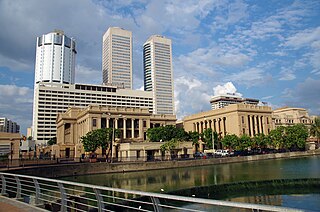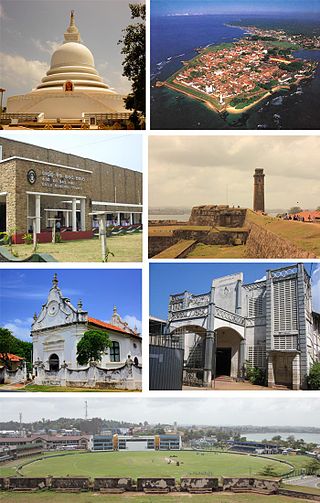
Sri Lanka, historically known as Ceylon and officially the Democratic Socialist Republic of Sri Lanka, is an island country in South Asia. It lies in the Indian Ocean, southwest of the Bay of Bengal, separated from the Indian peninsula by the Gulf of Mannar and the Palk Strait. It shares a maritime border with the Maldives in the southwest and India in the northwest.

Colombo is the executive and judicial capital and largest city of Sri Lanka by population. According to the Brookings Institution, the Colombo metropolitan area has a population of 5.6 million, and 752,993 in the Municipality. It is the financial centre of the island and a tourist destination. It is located on the west coast of the island and adjacent to the Greater Colombo area which includes Sri Jayawardenepura Kotte, the legislative capital of Sri Lanka, and Dehiwala-Mount Lavinia. Colombo is often referred to as the capital since Sri Jayawardenepura Kotte is itself within the urban/suburban area of Colombo. It is also the administrative capital of the Western Province and the district capital of Colombo District. Colombo is a busy and vibrant city with a mixture of modern life, colonial buildings and monuments.

Galle is a major city in Sri Lanka, situated on the southwestern tip, 119 km (74 mi) from Colombo. Galle is the provincial capital and largest city of Southern Province, Sri Lanka and is the capital of Galle District.

The United National Party is a centre-right political party in Sri Lanka. The UNP has served as the country's ruling party, or as part of its governing coalition, for 38 of the country's 74 years of independence, including the periods 1947–1956, 1965–1970, 1977–1994, 2001–2004 and 2015–2019. The party also controlled the executive presidency from its formation in 1978 until 1994 and back in 2022.

Tourism in Sri Lanka faces many challenges, including the ongoing economic and political crisis. In 2018, tourist arrivals peaked at 2.5 million, who spent a total of US$ 5.6 billion in the country. However, the COVID-19 pandemic caused tourist numbers to decrease by 92% in 2020. As of 2022, tourist numbers have not rebounded from the pre-crisis high. The government is attempting to attract foreign investment in the country's tourism industry, which began in earnest after the end of the Sri Lankan Civil War in 2009.

The culture of Sri Lanka mixes modern elements with traditional aspects and is known for its regional diversity. Sri Lankan culture has long been influenced by the heritage of Theravada Buddhism passed on from India, and the religion's legacy is particularly strong in Sri Lanka's southern and central regions. South Indian cultural influences are especially pronounced in the northernmost reaches of the country. The history of colonial occupation has also left a mark on Sri Lanka's identity, with Portuguese, Dutch, and British elements having intermingled with various traditional facets of Sri Lankan culture. Additionally, Indonesian culture has also influenced certain aspects of Sri Lankan culture. Culturally, Sri Lanka possesses strong links to both India and Southeast Asia. For over 2,500 years, India and Sri Lanka have nurtured a legacy of historical, cultural, religious, spiritual, and linguistic connections.

The Galle Face Hotel, founded in 1864, is one of the oldest hotels east of Suez. It is located on Galle Road, Colombo. The Ceylon Hotels Corporation is now part of the Galle Face Hotel Group. The hotel is a member of Select Hotels and Resorts International. The current chairman of the hotel is Sanjeev Gardiner, since the demise of his father Cyril Gardiner in 1997. It is listed as one of the "1000 Places to See Before You Die" in the book of the same name. It received the "Best Heritage Hotel" title three years running at the Presidential Awards for Travel and Tourism, held in June 2010, June 2011 and September 2012. In addition it won the first-ever PATA award for Best International Heritage Hotel, in 2012. In September 2012, it became the first hotel in Sri Lanka to be featured on a postage stamp, along with three other iconic buildings in Colombo.

Pachliopta pandiyana, the Malabar rose, is a swallowtail butterfly belonging to the genus Pachliopta, the roses or red-bodied swallowtails.

The Toluvila statue is a seated image of the Buddha discovered in 1900 in Anuradhapura, Sri Lanka, that dates back to the 4th or 5th century. Carved out of granite, it is one of the best-preserved sculptures from Sri Lanka and is similar to the Samadhi statue of Anuradhapura. Some features of the statue indicate that it may have been influenced by the Mathura School. The statue is now kept at the National Museum of Colombo.

The Colombo National Museum, also known as the Sri Lanka National Museum, is a museum in Colombo and the largest in Sri Lanka. Founded in 1877 and maintained by the Department of National Museums, it holds collections of significant importance to Sri Lanka, such as the regalia of the Kandyan monarchs, as well as many other exhibits relating the country's cultural and natural heritage.

Achchige Patali Champika Ranawaka is a Sri Lankan electrical engineer and Far-right politician. He is the Member of Parliament from Colombo District of Samagi Jana Balawegaya. He is currently the leader of a Civil Society named "43rd Brigade", after declaring to be an Independent Member of Parliament on 8 June 2022. He was the Cabinet Minister of Megapolis and Western Development, as well as Minister of Environment and Natural Resources, Power and Energy and Technology, Research and Atomic Energy.

Deforestation is one of the most serious environmental issues in Sri Lanka. Sri Lanka's current forest cover as of 2017 was 29.7%. In the 1920s, the island had a 49 percent forest cover but by 2005 this had fallen by approximately 26 percent. Between 1990 and 2000, Sri Lanka lost an average of 26,800 ha of forests per year. This amounts to an average annual deforestation rate of 1.14%. Between 2000 and 2005 the rate accelerated to 1.43% per annum. However, with a long history of policy and laws towards environmental protection, deforestation rates of primary cover have decreased 35% since the end of the 1990s thanks to a strong history of conservation measures. The problem of deforestation in Sri Lanka is not as significant in the southern mountainous regions as it is in northern and lowland southern Sri Lanka, largely due to the nature of environmental protection.

Central Highlands of Sri Lanka is a recognised World Heritage Site in Sri Lanka. The site comprises the Peak Wilderness Protected Area, the Horton Plains National Park and the Knuckles Conservation Forest. These are rain forests, where the elevation reaches 2,500 metres (8,200 ft) above sea level. The region harbors a variety of mammal species including the bear monkey, Trachypithecus vetulus monticola, and the Horton Plains slender loris, Loris tardigradus nycticeboides,.

Galle Fort, in the Bay of Galle on the southwest coast of Sri Lanka, was built first in 1588 by the Portuguese, then extensively fortified by the Dutch during the 17th century from 1649 onwards. It is a historical, archaeological and architectural heritage monument, which even after more than 432 years maintains a polished appearance, due to extensive reconstruction work done by the Archaeological Department of Sri Lanka.

Rohan David Pethiyagoda is a Sri Lankan biodiversity scientist, amphibian and freshwater-fish taxonomist, author, conservationist and public-policy advocate.
The National Museum of Ratnapura is one of the national museums of Sri Lanka. It is located in Ratnapura, Sri Lanka and it was opened on 13 May 1988. The museum building is called “Ehelepola Walauwa”, as it once belonged to Ehelepola Nilame, a courtier of the Kingdom of Kandy, who was the 1st Adigar under the reign King Sri Vikrama Rajasinha, the last king of Sri Lanka, for whom he served as the Disawe of Ratnapura.
















